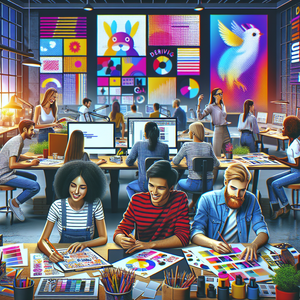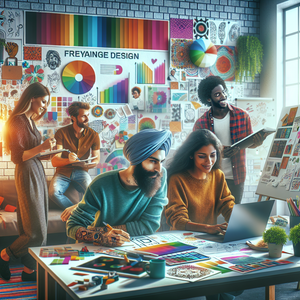
Exploring New Horizons: A Detailed Look at Entry-Level Graphic Design Careers in 2024
In 2024, the world of entry-level graphic design jobs is flourishing, particularly in vibrant cities like New York City, where the appetite for creative talent is on the rise. As businesses increasingly prioritize digital aesthetics and brand presence, graphic designers are becoming vital players in shaping visual narratives. Entry-level designers engage in a diverse range of tasks, from crafting layouts and selecting color schemes to creating graphics for both print and digital media. Typically, these positions require a bachelor’s degree in graphic design or a related discipline, familiarity with design software such as Adobe Creative Suite, and a compelling portfolio that showcases relevant skills. While competition for these roles can be intense, numerous avenues exist for aspiring designers to enter the field, including internships, freelance opportunities, and robust networking. Gaining a clear understanding of salary ranges, job duties, and the level of creative autonomy associated with different roles is essential for those looking to break into this industry. This guide delves into various entry-level job titles in graphic design, shedding light on daily responsibilities, necessary skills, and their significance within the broader design ecosystem. Whether you’re just starting your career or contemplating a shift, this article aims to illuminate the diverse paths available in graphic design.
Job Summaries:
Entry-Level Graphic Designer:
- This role involves creating visual content across various media, including websites, advertisements, and social media.
- Collaboration with senior designers helps newcomers understand project objectives and refine their designs.
- This position is crucial for building a portfolio and gaining industry experience.
Junior Art Director:
- Support creative projects from start to finish.
- Work closely with graphic designers, copywriters, and other creatives.
- Ensure visual elements align with brand strategies.
- A degree in graphic design or a related area is typically needed.
- A strong portfolio is typically needed.
Logo Designer:
- Specializing in crafting unique logos that reflect a brand’s identity
- Logo designers conduct research on industry trends and client needs
- Success in this role hinges on a solid portfolio
- Proficiency in design software is essential
Entry-Level Web Designer:
- Web designers focus on developing visually attractive and user-friendly websites.
- Collaborating with developers and UX designers is essential to ensure both beauty and functionality.
- A background in graphic design and basic HTML/CSS knowledge are advantageous.
Freelance Graphic Designer:
- Freelancers tackle diverse projects for various clients.
- Freelancers allow for flexible work hours.
- A degree can be helpful but is not necessary.
- A strong portfolio is vital for attracting clients.
- Networking skills are essential for attracting clients.
- Building a varied and impressive portfolio is important.
Marketing Coordinator:
- While primarily a marketing role, a marketing coordinator with graphic design skills plays a key part in creating promotional materials.
- Creating social media visuals is another important aspect of the role.
- Email campaigns are also a significant responsibility.
- Strong organizational abilities are crucial for success in this position.
- Collaboration with various teams is essential.
User Experience (UX) Designer:
- UX designers focus on enhancing user satisfaction through improved product usability.
- This involves conducting user research, creating wireframes, and working with developers for an optimal user experience.
- Familiarity with UX design tools is often required.
Social Media Graphic Designer:
- Crafting engaging visuals for social media
- Ensuring alignment with marketing campaigns and brand messaging
- Staying abreast of current trends
- Being proficient in design software
Illustrator:
- Illustrators create images for books, advertisements, and digital platforms.
- A strong artistic ability coupled with the skill to translate concepts into visuals is crucial.
- A diverse portfolio can significantly enhance job prospects.
Infographic Designer:
- Infographic designers specialize in turning complex data into visually engaging formats.
- Collaborating with researchers and writers, they create infographics that communicate crucial messages effectively.
Print Designer:
- Focused on materials for physical distribution like brochures and posters
- Print designers require a deep understanding of color theory
- They need knowledge of typography
- They must understand printing processes
- Proficiency in design software is essential
Brand Designer:
- Brand designers develop and uphold a brand's visual identity through elements like logos and color schemes.
- A solid portfolio and a degree in graphic design are essential for this influential role.
Packaging Designer:
- This role involves creating product packaging that is both functional and aesthetically pleasing.
- Requires knowledge of materials and production processes.
Presentation Designer:
- Specializing in crafting visually compelling presentations
- Strong grasp of design principles
- Strong storytelling skills
- Proficiency in presentation software
Motion Graphics Designer:
- Motion graphics designers create animated content for videos and advertisements.
- Mastery of animation software and a creative vision are vital for success in this dynamic role.
Visual Designer:
- Visual designers ensure consistent aesthetics across a brand's platforms.
- They focus on graphic creation and color selection.
- This is crucial for brand identity development.
Editorial Designer:
- This role revolves around designing layouts for publications.
- Requiring strong typography skills.
- An understanding of print production processes.
Environmental Graphic Designer:
- These designers craft visual experiences within physical spaces.
- They create elements such as signage and murals.
- The role demands strong spatial awareness.
- Creativity is essential in this field.
Product Designer:
- Product designers prioritize user experience and aesthetics
- Collaborate with engineers and marketers
- Engage in prototyping and visual design
Exhibition Designer:
- Exhibition designers conceptualize immersive displays for museums and trade shows.
- They require creative and project management skills.
- Their goal is to create memorable visitor experiences.
As you embark on your journey toward an entry-level graphic design position, keep in mind the wealth of opportunities within this vibrant field. By developing a strong portfolio, networking strategically, and honing essential skills, you can carve out a successful career in graphic design. Whether you aspire to work in-house or as a freelancer, the possibilities are expansive. Stay current with industry trends and salary expectations, and leverage tools that connect you with prospective employers. Your adventure in graphic design is just beginning—explore the myriad of job openings available and take that critical first step toward a rewarding career.
Explore More Jobs

